A mist hung over the pre-dawn woods, the dampness seeping through our clothes and chilling us to the bone. The car’s thermometer gauge displayed +3 degrees Celsius but we knew that could be way off. Here we were in Piedmont, Italy, deep in the Italian countryside sometime after 6 a.m. setting off with a group of sleepy but intrepid foreigners on that most fabled of odysseys, the hunt for white truffles.
Landing in Italy less than twenty four hours earlier, our first day had been a marathon that commenced with an early morning Milan arrival, meeting up with friends, struggling with a stick-shift Fiat and GPS, and driving rain. All the tension would thankfully be eased by piles of white truffles, some Barolo and … more Barolo.
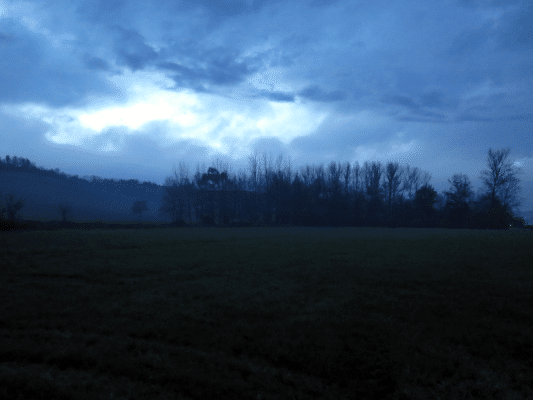
We woke the next day at 4:45am, shaking off our jet lag, to set out in pitch blackness on our rendezvous. An hour and a half later, our little caravan pulled off the road and into the muck to meet restaurateur and truffle hunter Sandro Romanelli and his dog, Viggo.
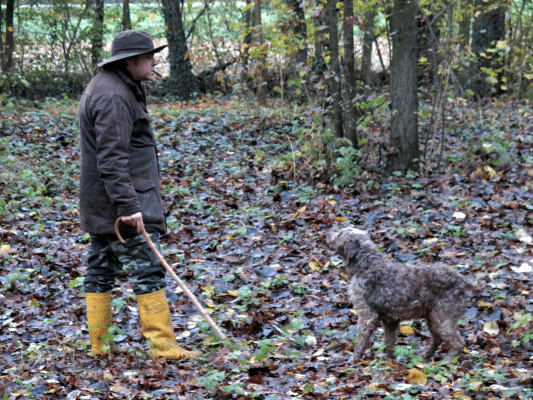
A few words about the white truffle or the tuber magnatum. This ultra-expensive delicacy, which routinely goes for upwards of $100 for a few grams shaved over your food, is only in season September through early January. In a good year, with a cold, wet summer, a bumper crop would lower the outrageously expensive prices and make them more plentiful in restaurants. Depending on each restaurant, expect to pay €25-35 for 10 grams shaved over a dish, typically eggs, pasta, risotto or veal tartare – anything that will sustain the aroma and flavor. While truffles can be found as early as September, the best are in late November or December after the first frost, which deepens their aroma. The town of Alba has a heavily promoted International White Truffle Fair starting in mid-October but according to the locals that’s not when the best truffles are found. It’s best to avoid this touristy time and travel to the region a bit later around Thanksgiving or after.
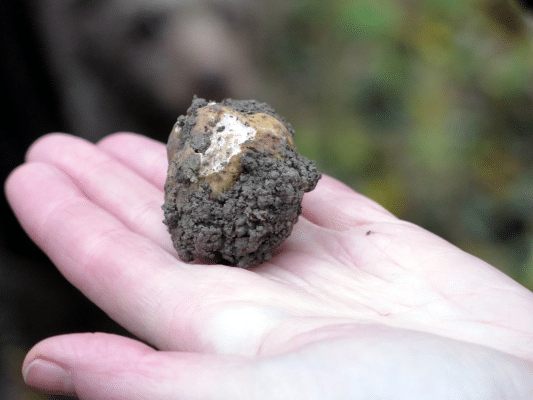
One thing to keep in mind if you ever embark on a truffle hunt is that it probably won’t be 100% authentic. The amount of money involved in this business clouds the process. You’ll hear tales of secret hunting places (yes, they exist) and the “truffle mafia” abducting truffle dogs but one thing’s certain – you’re not going to be hunting where the most prized specimens are found. In all likelihood, you’ll be on a truffle preserve where a sign reads that anyone with a license can hunt within. Friends of ours had already been on one sketchy truffle hunt in Umbria, and – miracle of miracles! – three truffles were found in short order just beneath the surface of a plot that can best be described as ludicrously small. Luckily for us, we had a good local connection which guaranteed a real search (with no pre-planted truffles), even if it wasn’t in a secret location.
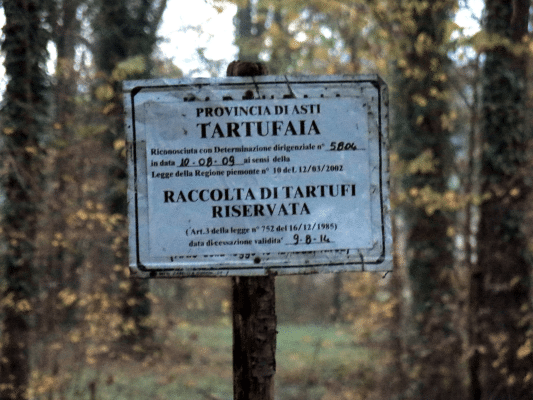
As the world turns slate gray around us we patiently wait, shifting from one foot to another with an occasional stamp to keep the blood flowing. Sandro takes us one by one and pulls blue plastic booties over our mud-caked shoes. That these booties are in place, our shoes (and feet) will soon be grateful. Viggo is vivacious and a real charmer, obviously a people dog. Alas, we soon learn that people can easily distract from the task at hand. On this particular day, Viggo has been working since 2a.m. in search of the prized tuber and he’s a bit punchy, preferring to play with us rather than do more work. “Don’t humor the dog,” I tell myself as we set out, hanging back to get him to concentrate again.
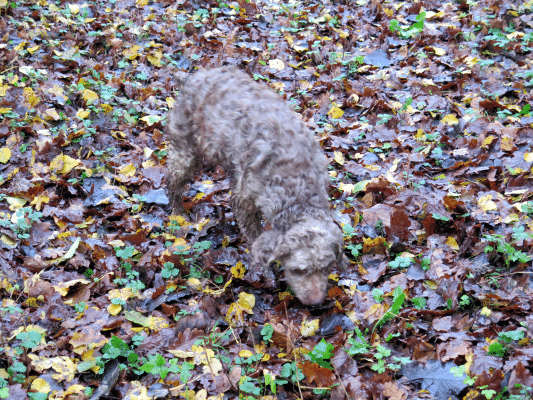
At first Viggo seems scattered and Sandro, nonchalantly puffing on a cigar, taps the ground repeatedly with a walking stick. “Piano, piano,” he shouts, urging the dog to be more, well, dogged (piano means go slow). But Viggo is not in a persistent mood and takes off, practically leaving the job altogether. Soon, though, Viggo catches a scent and Sandro launches into action. Remember the old adage about how dogs are better than pigs because they don’t eat truffles? Hogwash. Dogs definitely eat truffles. Instantaneously Sandro is on his knees in the muck, his left hand fending off an eager Viggo, his right digging for the elusive white golden nugget. He bounces up, success! He smells the specimen then shakes his head. “Green.” We huddle around and inhale, not getting much. He pockets it anyway, rewards Viggo, then kicks mud and leaves over the hole. Fifteen minutes have passed.
It starts to warm up as the forest brightens into a ghostly gray, yet we’re still shivering. Time passes and we seem to have a distracted dog on our hands, “Piano! Piano!” Sandro shouts, as lightning fast Italian cars zoom past us on the road. We think of the white truffle breakfast that awaits us, assuming that more truffles are going to be found. “Come on Viggo, get it together,” I think. We move on, Sandro casually mentioning that often dogs are muzzled so they don’t eat the truffles. And also to avoid being poisoned. Aha! Some of the tales are true.
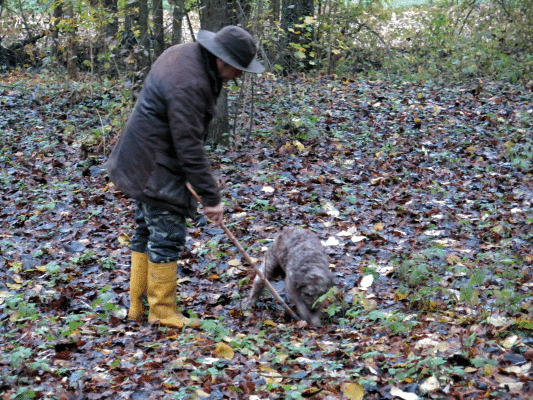
After an eon of wandering around, Sandro is again on the move, Viggo digging at the semi-frozen dirt, Sandro pushing him aside, Viggo trying to leap over his handler’s arm. Another truffle is found. This time we can smell it before we even get close. This one is good, Sandro proudly extending his hand for all to see. A short time later, a third and final truffle is found, one deemed good enough for breakfast.
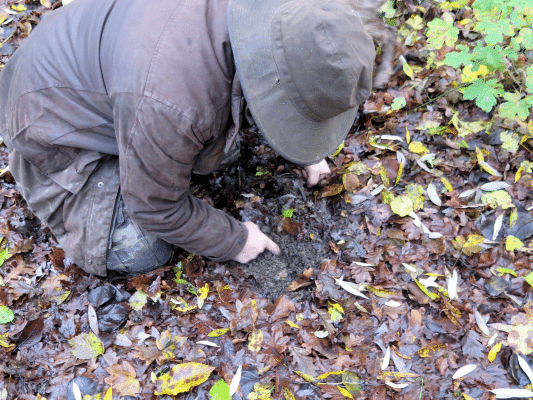
As we head out of the woods to promises of warmth and truffled eggs, traditionally consumed with glasses of Barbaresco, Sandro mentions one primary rule. Should you see a fellow hunter as you’re leaving, if he asks what you’ve found say, “not much,” preferably with a shrug of the shoulders. As we reach our vehicles, indeed there’s a man there, a truffle hunting colleague and he eagerly unfolds his hand to display a mini pile of truffles, both black and white.
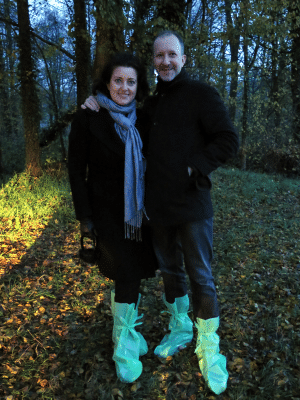
How much is real? Will we ever really know? It’s hard to say but I can tell you that breakfast was terrific.
[alert type=white]
www.italia.it/en/discover-italy/piedmont
[/alert]

